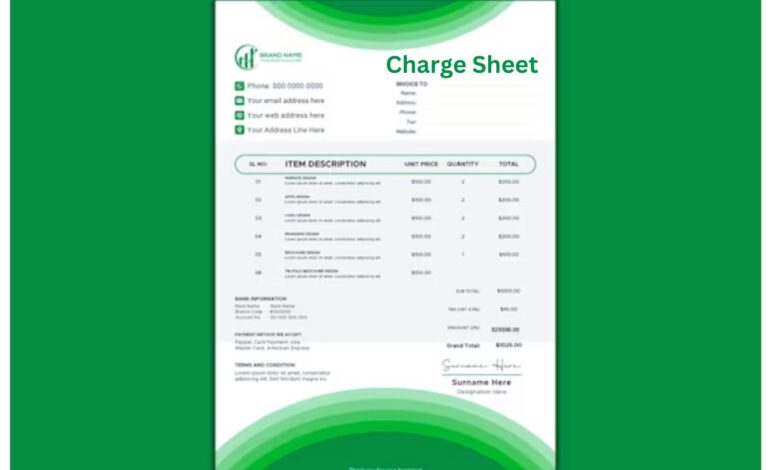Charge Sheet : Explained Key Details and Legal Process

Imagine being charged with a crime and facing a criminal trial. The first official step that occurs is the charge sheet, which is a crucial document that formally accuses a person of committing a crime. However, what does a charge sheet really entail, and how does it affect the proceedings of a criminal case? In this comprehensive guide, we will break down everything you need to know about charge sheets — from their definition and role in legal procedures to how they influence both the defense and prosecution.
Understanding charge sheets is essential for anyone navigating the criminal justice system. After all, they form the foundation of the trial. Without this critical document, there can be no prosecution, and, consequently, the entire case would not proceed to court. Therefore, knowing the details of a charge sheet is vital for anyone involved in the legal process.
What is a Charge Sheet?
Key components typically included in a charge sheet are:
- The identity of the accused
- A detailed description of the crime and its circumstances
- The evidence supporting the charge
- The names of witnesses
- The legal provisions under which the accused is being charged
A charge sheet is an important part of the criminal justice process because it informs both the accused and the court about the nature of the charges.
Key Features of a Charge Sheet
1. The Crime Description
This section explains in detail what crime the defendant is accused of committing. It outlines the specifics of the offense, such as the date, time, and location of the crime, and provides the facts around how the crime occurred.
- Examples: Theft, assault, embezzlement, or homicide.
- Details: The section may also explain if the crime was committed in the presence of a witness or if there were any aggravating factors such as violence.
2. Evidence Presented
- Direct Evidence: Evidence that directly links the accused to the crime (e.g., fingerprints, surveillance footage).
- Circumstantial Evidence: Indirect evidence that may suggest the accused’s involvement but is not conclusive (e.g., motive, behavior prior to the crime).
3. Legal Provisions and Sections
A charge sheet lists the specific sections of the law that the accused has violated. This provides a clear legal framework for the charges and ensures that the case is filed under the appropriate laws.
- Criminal Codes: Sections from the Criminal Procedure Code or Indian Penal Code (IPC), for instance, are commonly referenced.
- Relevant Legal Terms: Defines legal terms like ‘intent’, ‘premeditation’, or ‘negligence’, based on the crime.
4. Accused’s Personal Details
This section includes all the personal details of the accused, such as their name, age, address, occupation, and criminal history (if any). It may also include the accused’s statement, if taken during the investigation.
- Criminal Record: Information about prior offenses committed by the accused, if any.
- Defendant’s Defense: In some cases, the charge sheet will include the defendant’s side of the story or a brief on any alibis or explanations they offer.
5. Witnesses and Statements
A list of witnesses who have provided testimony is included in the charge sheet. The statements of these witnesses help build the case and provide additional context to the events described.
- Eyewitness Testimonies: Statements from people who witnessed the crime.
- Expert Witnesses: Forensic experts, psychologists, or medical professionals who testify about evidence related to the case.
The Legal Process Following the Charge Sheet
Once the charge sheet is filed with the court, the judicial process begins. Below is a breakdown of what happens next:
1. Preliminary Hearing
- Role of Defense: The defense may challenge the charges, request a bail hearing, or argue that the evidence is insufficient.
- Role of Prosecution: The prosecution must provide sufficient evidence and legal justification for the charges.
2. Trial Procedure
If the case goes to trial, the court will consider the charge sheet as the foundation of the prosecution’s argument. Both sides will present their evidence and arguments, and witnesses will testify.
- Cross-Examination: The defense may cross-examine witnesses to challenge their testimonies or discredit the evidence.
- Defensive Arguments: The defense team may present alibis, inconsistencies in the charge sheet, or arguments that the evidence doesn’t prove guilt beyond a reasonable doubt.
3. Judgment
After the trial concludes, the judge or jury will deliver a verdict. If the defendant is found guilty, sentencing will follow based on the severity of the crime and any mitigating factors. If the defendant is acquitted, the case is closed.
Challenges with Charge Sheets
While charge sheets are crucial documents in the criminal justice system, they are not without their challenges. Here are some common issues faced with charge sheets:
1. Errors or Inaccuracies in the Charge Sheet
- Impact on Defense: Such errors can give the defense an opportunity to argue that the charges are flawed or baseless.
- Remedies: Courts may allow corrections or amendments to be made before the trial begins.
2. Insufficient Evidence
- Prosecution’s Challenge: If the charge sheet lacks concrete evidence, proving the accused’s guilt becomes difficult.
- Defense Strategy: The defense can argue that the case lacks merit, pushing for the case to be dropped.
3. False Accusations
- Defamation: False charges can lead to reputational harm for the accused, even if they are later found not guilty.
How Charge Sheets Impact the Defense Strategy
The defense’s approach to a criminal case is heavily influenced by the content of the charge sheet. It allows the defense team to:
- Review Evidence: Study the charge sheet carefully to identify any flaws, inconsistencies, or holes in the prosecution’s case.
- Build Counter-Evidence: The defense may present its own evidence that contradicts or questions the charge sheet’s claims.
- Request Discharge or Bail: If the charge sheet lacks sufficient evidence, the defense can request a discharge or bail for the accused.
Future Trends in Charge Sheets
The legal system is evolving, and so is the role of charge sheets. Here are some trends we can expect to see:
1. Digital Charge Sheets
As technology advances, many jurisdictions are moving towards digital charge sheets. These are easier to file, access, and update. Digital charge sheets will likely reduce errors and improve the efficiency of the criminal justice process.
- Faster Processing: Faster preparation and submission of charge sheets.
- Enhanced Security: Digital charge sheets can be protected with encryption, reducing the risk of tampering or loss.
2. Greater Use of Forensic Evidence
- Forensic Reports: Increased reliance on expert testimony and forensic reports.
- Accuracy and Reliability: The use of DNA analysis and other methods ensures more reliable evidence.
3. Artificial Intelligence (AI) in Legal Systems
- Automated Document Review: AI can help lawyers quickly assess charge sheets and other legal documents.
- Predictive Analysis: AI tools might assist in predicting case outcomes based on past rulings.
Frequently Asked Questions (FAQs)
1. What is the difference between a charge sheet and a First Information Report (FIR)?
An FIR is the initial report filed with the police to notify them of a crime. It triggers the investigation. A charge sheet, on the other hand, is filed after the investigation is complete and details the formal charges against the accused.
2. Can the charge sheet be used as evidence in court?
Yes, the charge sheet itself may be presented as part of the evidence during the trial, but it is the evidence included within the charge sheet (such as witness statements or forensic evidence) that plays a key role.
3. How long does it take to receive a charge sheet after an arrest?
The timeline for receiving a charge sheet varies depending on the complexity of the case and jurisdiction. It can range from a few weeks to several months.
4. What happens if the charge sheet is rejected?
If a charge sheet is rejected due to errors or insufficient evidence, the police may be required to conduct further investigations or correct any mistakes before resubmitting it.
5. Can the charge sheet be contested?
Yes, the accused can contest the charge sheet by challenging the evidence, legal grounds, or the validity of the charges in court.


